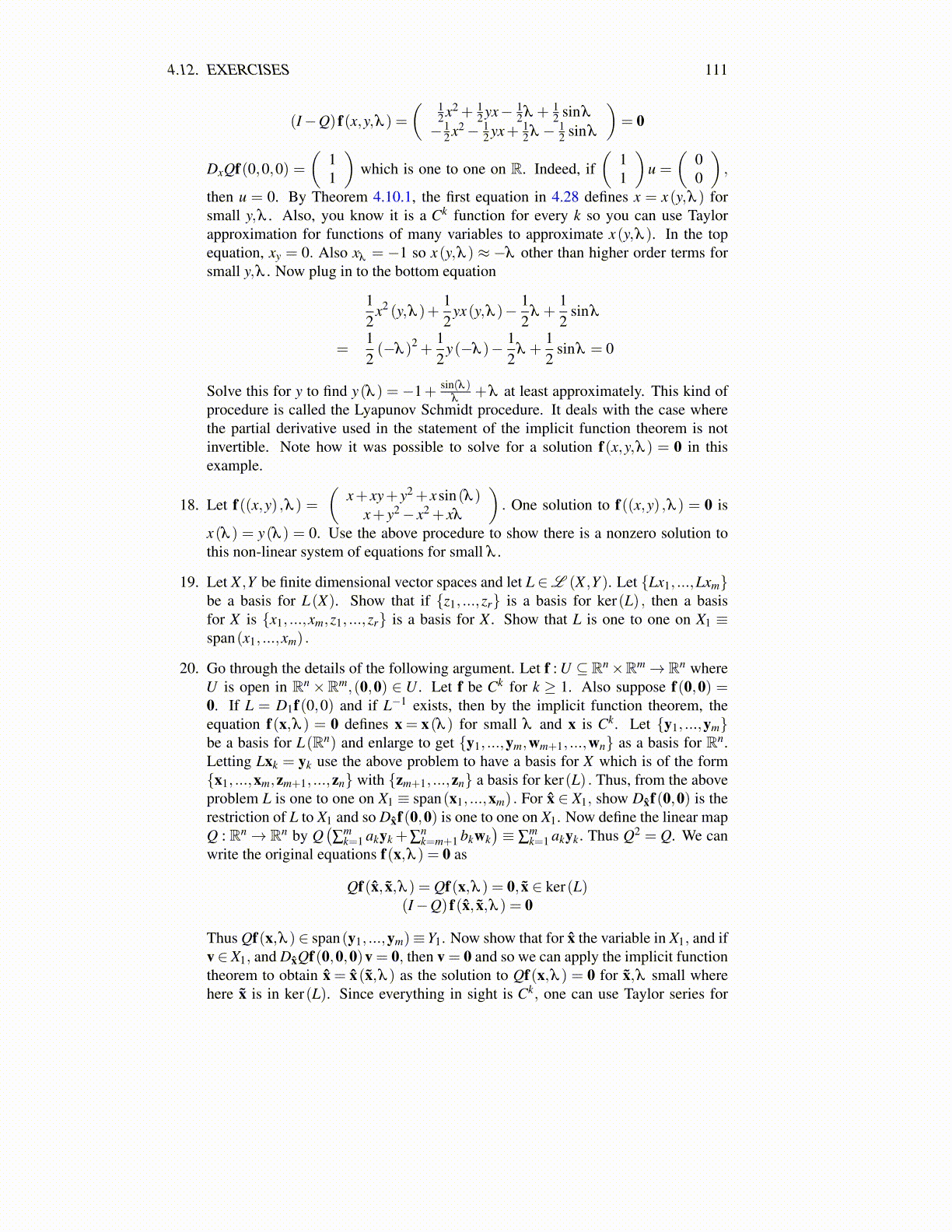
4.12. EXERCISES 111
(I−Q) f(x,y,λ ) =( 1
2 x2 + 12 yx− 1
2 λ + 12 sinλ
− 12 x2− 1
2 yx+ 12 λ − 1
2 sinλ
)= 0
DxQf(0,0,0) =(
11
)which is one to one on R. Indeed, if
(11
)u =
(00
),
then u = 0. By Theorem 4.10.1, the first equation in 4.28 defines x = x(y,λ ) forsmall y,λ . Also, you know it is a Ck function for every k so you can use Taylorapproximation for functions of many variables to approximate x(y,λ ). In the topequation, xy = 0. Also xλ = −1 so x(y,λ ) ≈ −λ other than higher order terms forsmall y,λ . Now plug in to the bottom equation
12
x2 (y,λ )+12
yx(y,λ )− 12
λ +12
sinλ
=12(−λ )2 +
12
y(−λ )− 12
λ +12
sinλ = 0
Solve this for y to find y(λ ) = −1+ sin(λ )λ
+λ at least approximately. This kind ofprocedure is called the Lyapunov Schmidt procedure. It deals with the case wherethe partial derivative used in the statement of the implicit function theorem is notinvertible. Note how it was possible to solve for a solution f(x,y,λ ) = 0 in thisexample.
18. Let f((x,y) ,λ ) =(
x+ xy+ y2 + xsin(λ )x+ y2− x2 + xλ
). One solution to f((x,y) ,λ ) = 0 is
x(λ ) = y(λ ) = 0. Use the above procedure to show there is a nonzero solution tothis non-linear system of equations for small λ .
19. Let X ,Y be finite dimensional vector spaces and let L ∈L (X ,Y ). Let {Lx1, ...,Lxm}be a basis for L(X). Show that if {z1, ...,zr} is a basis for ker(L) , then a basisfor X is {x1, ...,xm,z1, ...,zr} is a basis for X . Show that L is one to one on X1 ≡span(x1, ...,xm) .
20. Go through the details of the following argument. Let f : U ⊆ Rn×Rm→ Rn whereU is open in Rn×Rm,(0,0) ∈ U . Let f be Ck for k ≥ 1. Also suppose f(0,0) =0. If L = D1f(0,0) and if L−1 exists, then by the implicit function theorem, theequation f(x,λ ) = 0 defines x = x(λ ) for small λ and x is Ck. Let {y1, ...,ym}be a basis for L(Rn) and enlarge to get {y1, ...,ym,wm+1, ...,wn} as a basis for Rn.Letting Lxk = yk use the above problem to have a basis for X which is of the form{x1, ...,xm,zm+1, ...,zn} with {zm+1, ...,zn} a basis for ker(L) . Thus, from the aboveproblem L is one to one on X1 ≡ span(x1, ...,xm) . For x̂ ∈ X1, show Dx̂f(0,0) is therestriction of L to X1 and so Dx̂f(0,0) is one to one on X1. Now define the linear mapQ : Rn→ Rn by Q
(∑
mk=1 akyk +∑
nk=m+1 bkwk
)≡ ∑
mk=1 akyk. Thus Q2 = Q. We can
write the original equations f(x,λ ) = 0 as
Qf(x̂, x̃,λ ) = Qf(x,λ ) = 0, x̃ ∈ ker(L)(I−Q) f(x̂, x̃,λ ) = 0
Thus Qf(x,λ )∈ span(y1, ...,ym)≡Y1. Now show that for x̂ the variable in X1, and ifv∈ X1, and Dx̂Qf(0,0,0)v = 0, then v = 0 and so we can apply the implicit functiontheorem to obtain x̂ = x̂(x̃,λ ) as the solution to Qf(x,λ ) = 0 for x̃,λ small wherehere x̃ is in ker(L). Since everything in sight is Ck, one can use Taylor series for